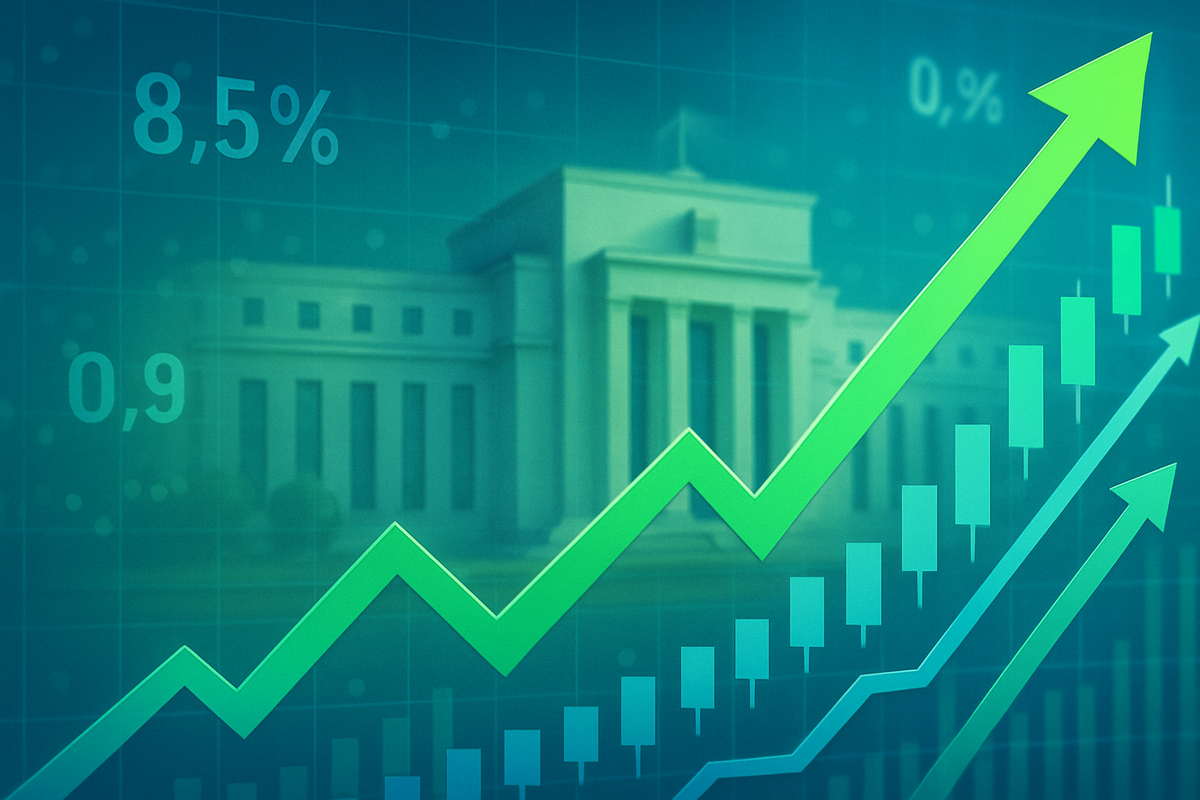
Optimism has surged through financial markets as recent economic data, particularly the July Consumer Price Index (CPI), has significantly bolstered expectations for a 25-basis-point interest rate cut by the Federal Reserve in September. This shift in sentiment reflects a growing belief that the central bank may pivot towards supporting economic growth amidst signs of moderating consumer inflation.
However, this newfound market confidence is not without its caveats. The subsequent release of a hotter-than-expected Producer Price Index (PPI) report for July has introduced a degree of caution, reminding investors that the path to monetary easing may still be fraught with inflationary pressures from the supply side. The interplay of these two crucial inflation indicators is now shaping the narrative for the Fed's upcoming policy decisions, creating a complex landscape for investors and businesses alike.
Inflation's Mixed Signals: CPI Cools, PPI Heats Up
The catalyst for the recent market rally was the July Consumer Price Index (CPI) report, which showed a slightly cooler-than-forecast rise in consumer prices. Headline CPI increased by a modest 0.2% month-over-month and 2.7% on an annual basis, marginally below economists' projections of 2.8% year-over-year. While core CPI, excluding volatile food and energy prices, rose 0.3% monthly and 3.1% annually—its highest level in five months—analysts generally viewed the overall CPI print as not "hot enough to derail" a September rate cut. This relatively tame inflation data, coupled with a weakening labor market that saw hiring slow in July, led investors to increasingly bet on the Federal Reserve prioritizing economic support over inflation containment.
Following the CPI release, the probability of a September rate cut, as tracked by the CME FedWatch tool, surged from around 85.9% to over 94%, with some forecasts even reaching 90% certainty. This immediate reaction reflected a market belief that the Fed would likely turn its attention to boosting the job market, which had shown signs of losing steam.
However, the optimism generated by the CPI data was quickly reined in by the release of the July Producer Price Index (PPI) report. The PPI, which measures wholesale inflation, surged by 0.9% month-over-month, significantly exceeding the consensus forecast of a 0.2% increase and marking the largest monthly gain since June 2022. On an annual basis, headline PPI rose to 3.3%, well above the Federal Reserve's 2% target and economists' expectations. Core PPI, which excludes food, energy, and trade services, also saw a substantial increase of 0.6% month-over-month, its largest gain since March 2022. This hotter-than-expected wholesale inflation report immediately raised concerns that businesses, facing higher input costs (partially due to tariffs), might soon pass these increases on to consumers, potentially reigniting consumer inflation. In response, traders "dialed back" their expectations for a September rate cut. While a September cut remained largely anticipated, the certainty diminished, and the probability of the Fed holding rates steady increased from near 0% to over 7.5% in some models. The surprise PPI reading "muddies the central bank's September decision" and reinforces a "wait-and-see" approach for the Federal Reserve, as policymakers balance their dual mandate of maintaining maximum employment and price stability.
Navigating the Shifting Tides: Potential Winners and Losers
The prospect of a Federal Reserve interest rate cut, even if tempered by recent PPI data, creates a distinct landscape of potential winners and losers across various sectors of the financial market. Companies that are highly sensitive to interest rates, such as those in the real estate, technology, and consumer discretionary sectors, often stand to benefit significantly from lower borrowing costs and increased consumer spending. Conversely, sectors that thrive in higher interest rate environments, like traditional banking and some financial services, might face headwinds.
Winners:
- Real Estate and Homebuilding: This sector is a primary beneficiary as lower interest rates directly translate to more affordable mortgages, stimulating demand for new homes and refinancing activity. Property investments become more economically viable due to lower debt payments. Public companies like Welltower (NYSE: WELL), a senior housing specialist, and homebuilder Lennar (NYSE: LEN) stand to gain from reduced borrowing costs and increased housing demand. Zillow (NASDAQ: Z, ZG) would also see a boost from increased home-buying activity and associated ad revenue.
- Consumer Discretionary: With lower interest payments on loans and mortgages, consumers have more disposable income, leading to improved sentiment and increased spending on non-essential goods and services. Luxury goods retailers such as Ralph Lauren (NYSE: RL) and general retailers like Target (NYSE: TGT) could see increased demand.
- Information Technology / Technology: Tech companies often require substantial capital for research and development (R&D), innovation, and expansion. Lower finance costs on debt and lower discount rates used in valuation models can lead to higher stock valuations for growth-oriented tech companies. Major players like Nvidia (NASDAQ: NVDA), Apple (NASDAQ: AAPL), and Tesla (NASDAQ: TSLA) could see their valuations boosted. Fintech companies like Block (NYSE: SQ) also have high exposure to consumer spending and could see improved margins on credit products.
- Companies with Significant Debt Loads: Businesses with substantial debt can see a direct positive impact as their interest expenses decrease, improving free cash flow and profitability. AbbVie (NYSE: ABBV), Verizon Communications (NYSE: VZ), and Exxon Mobil (NYSE: XOM) are examples of companies with significant debt that could benefit from cheaper financing.
- Utilities: Often considered defensive dividend-payers, utilities compete with bonds for income investors. When bond yields drop due to lower interest rates, utilities become relatively more attractive, increasing demand for their stocks. Constellation Energy (NASDAQ: CEG) and WEC Energy Group (NYSE: WEC) are utility stocks that could see gains.
Losers:
- Financials (especially Banks and Insurance): While financial institutions might see increased loan demand, a primary challenge for banks is the compression of Net Interest Margins (NIM). When the Federal Reserve cuts its benchmark rate, the interest banks earn on loans tends to fall faster than the interest they pay on deposits, squeezing their profitability. Insurance companies, particularly those with long-duration liabilities, can also be adversely affected as lower interest rates reduce the present value of their future cash flows and the returns on their fixed-income investment portfolios. Major banks like JPMorgan Chase (NYSE: JPM) and Bank of America (NYSE: BAC) could see pressure on their net interest income.
- Cash-Heavy Companies: Businesses that hold significant cash reserves and rely on interest income from those holdings may see their revenue decrease as prevailing interest rates decline.
- Defensive Sectors (in a strong recovery): While consumer staples, utilities, and healthcare can be defensive plays during economic slowdowns, they might lose some appeal as the market rebounds and investors pivot towards more cyclical, growth-oriented sectors to capture opportunities in an improving economy.
Industry Impact and Broader Implications: A Balancing Act
The Federal Reserve's potential September rate cut, influenced by the conflicting signals from CPI and PPI data, fits into a broader narrative of central banks navigating a complex economic environment. Globally, many central banks are grappling with the dual challenge of taming inflation while avoiding a significant economic downturn. This event highlights the delicate balancing act the Fed faces in achieving its dual mandate of maximum employment and price stability.
- Broader Industry Trends: A Federal Reserve interest rate cut typically signals a move towards economic easing, often in response to slowing growth or disinflationary concerns. This can profoundly impact different sectors. Real estate and housing benefit from lower mortgage rates, stimulating demand. Technology and semiconductor companies, which require substantial capital for R&D and expansion, see reduced borrowing costs, making investments more attractive. Durable goods and luxury goods sectors also benefit from increased consumer spending due to more disposable income. Conversely, financial institutions, particularly banks, may face compressed net interest margins, though increased loan demand could partially offset this.
- Potential Ripple Effects on Competitors and Partners: Lower borrowing costs can intensify competition within industries as companies find it easier to secure funding for innovation and expansion. This could also lead to increased Mergers & Acquisitions (M&A) activity as larger players seek to acquire promising startups or consolidate market share. Supply chain partners could experience increased demand as overall economic activity picks up.
- Regulatory or Policy Implications: While rate cuts aim to stimulate growth, they can also lead to inflationary pressures if economic activity is stimulated too much. The Fed will scrutinize future economic data to ensure inflation remains under control. A prolonged period of low interest rates and an overly exuberant market rally could encourage excessive risk-taking and create asset bubbles, which regulators would need to monitor to prevent financial instability. Businesses should also review existing contracts and agreements, particularly those involving financing, to assess the impact of rate cuts on repayment terms and interest calculations.
- Historical Precedents and Comparisons: Historically, rate cuts have generally been bullish for stocks, encouraging investment and consumption. The S&P 500 has, on average, returned 14.2% in the 12 months following the first Fed rate cut since the 1980s. Past cycles, such as those following the dot-com bubble (2000-2003), the Global Financial Crisis (2007-2008), and the COVID-19 pandemic (2019-2020), demonstrate the Fed's decisive action in bringing down rates to support the economy. However, it's important to note that while inflation tends to fall during rate cut cycles, it has historically picked back up by an average of nearly 2 percentage points one year after the final rate cut. The current situation, with cooling CPI but hotter PPI, presents a unique challenge, as pipeline pressures from producers could eventually feed into consumer prices, creating a "tug-of-war" for the Fed between a weakening labor market and services-driven inflation.
What Comes Next: A Cautious Path Forward
The immediate focus for investors and policymakers will be the Federal Reserve's September meeting. While a 25-basis-point rate cut remains highly anticipated, the hotter-than-expected PPI data has introduced a degree of uncertainty regarding the magnitude and pace of future cuts. The Fed's decision will hinge on a careful balancing act between managing inflation and supporting employment.
- Short-Term Possibilities (3-12 months): Consumers could see reduced borrowing costs for credit cards, auto loans, and mortgages, potentially increasing spending. The stock market is likely to react positively, as lower borrowing costs can boost corporate profitability. Bond yields may decline, increasing the price of existing bonds. Economic growth could be stimulated, leading to higher job creation. However, savers might see reduced returns on savings accounts.
- Long-Term Possibilities (12+ months): Persistently low rates could lead to renewed inflationary pressures if the economy overheats, eroding consumer purchasing power. Market dynamics could shift, making traditional safe-haven investments less attractive and pushing investors towards higher-yielding, potentially riskier, alternatives. Lower rates could also further inflate asset prices.
- Strategic Pivots and Adaptations: Businesses may find it cheaper to finance operations and invest in growth. Investors might pivot towards cyclical sectors like industrials, consumer discretionary, and technology, which tend to outperform during rate-cutting cycles. Defensive sectors like consumer staples and healthcare also remain attractive due to their stable cash flows. Consumers, while benefiting from lower borrowing costs, should be mindful of potentially reduced returns on savings.
- Market Opportunities and Challenges: Opportunities include potential gains in equity sectors like financials, energy, consumer staples, healthcare, technology, and industrials. Falling bond yields make long-duration Treasuries and high-quality corporates attractive. Gold could also see renewed interest. Challenges include the risk of renewed inflationary pressures from the hotter PPI data, increased market volatility due to conflicting economic signals, and the possibility of an overvalued market. Small-cap stocks may face headwinds in a slowing economy.
- Potential Scenarios:
- "Soft Landing" (Most Anticipated): The Fed proceeds with a 25-basis-point cut, viewing cooling CPI and a softening labor market as primary signals. This could lead to moderate economic growth without significant inflation, and continued equity market rallies.
- "Stagflationary" Environment (Risk Scenario): The Fed cuts rates, but hotter PPI data and tariff impacts lead to persistent inflation despite a cooling job market, resulting in high inflation and slowing economic growth.
- Delayed or More Cautious Cuts (Less Likely but Possible): The Fed adopts a more cautious stance if PPI or other indicators suggest persistent inflationary pressures or a more resilient economy. This could lead to a market correction.
The upcoming September 16-17 FOMC meeting and Chairman Powell's speech at the Jackson Hole Economic Symposium will be pivotal in shaping market expectations and confirming the Fed's path.
Conclusion: A Market at a Crossroads
The current financial landscape is defined by a delicate balance of optimism and caution, largely driven by the Federal Reserve's anticipated interest rate decision in September. The better-than-expected July CPI data initially ignited hopes for a significant monetary easing cycle, propelling equity markets higher and signaling a potential pivot towards economic growth. However, the subsequent hotter-than-expected PPI report has injected a dose of reality, reminding investors that inflationary pressures, particularly from the supply side, remain a formidable challenge.
Key Takeaways:
- High Probability of September Rate Cut: Markets are overwhelmingly pricing in a 25-basis-point interest rate cut by the Federal Reserve in September, driven by cooling July CPI data and signs of a softening labor market.
- Conflicting Inflation Signals: While consumer inflation (CPI) has shown signs of moderating, producer inflation (PPI) came in hotter than expected, raising concerns about persistent underlying price pressures and potential future consumer price increases.
- Market Rally Already Priced In: Major U.S. stock indexes have already reached new highs in anticipation of the rate cut, suggesting that the immediate market reaction might be less dramatic than if the cut were unexpected.
- Sectoral Impact: Interest-rate-sensitive sectors like real estate, technology, and consumer discretionary are poised to benefit, while financials, particularly banks, may face challenges due to compressed net interest margins.
Assessment of the Market Moving Forward:
The market is at a crossroads. While the prospect of lower borrowing costs is generally bullish for equities, the conflicting inflation data creates uncertainty. If the Fed proceeds with the cut and inflation remains contained, a "soft landing" scenario is plausible, leading to continued moderate economic growth and a sustained equity rally. However, if the hotter PPI data proves to be a stronger indicator of future inflation, a "stagflationary" environment with high inflation and slowing growth could emerge, challenging corporate profit margins and market stability.
Significance and Lasting Impact:
A Federal Reserve rate cut signifies a crucial shift in monetary policy, moving from an anti-inflationary stance to one aimed at stimulating economic growth and job creation. The lasting impact will depend on how effectively the Fed navigates the dual challenge of managing inflation and supporting employment. While lower rates can improve corporate financial health and encourage expansion, they also carry the risk of renewed inflationary pressures and potential asset bubbles if not managed carefully. The Fed's actions have a significant "spillover effect" on global financial conditions, particularly in emerging markets.
What Investors Should Watch For in Coming Months:
Investors should remain vigilant and closely monitor:
- Future Inflation Data: The core Personal Consumption Expenditures (PCE) price index, the Fed's preferred inflation gauge, will be crucial. Any sustained uptick in inflation, especially due to tariffs, could delay further rate cuts.
- Labor Market Reports: Continued signs of weakening in the job market, such as rising unemployment or slowing job growth, would likely reinforce the Fed's dovish stance.
- Fed Officials' Commentary: Speeches and statements from Federal Reserve officials, particularly at the upcoming Jackson Hole symposium, will provide insights into their evolving outlook and potential future policy moves.
- Impact of Tariffs: The full effect of recent tariff implementations on inflation and economic growth remains a significant uncertainty.
- Corporate Earnings: Solid earnings growth remains a "convincing" bull case for the market and could provide a cushion against economic worries.
- Geopolitical Tensions: Global events and trade tensions can disrupt markets and influence Fed policy.
In essence, while a September rate cut appears highly probable and largely priced in, the path forward for the market will depend on the interplay of inflation, labor market dynamics, and the Fed's cautious, data-driven approach to subsequent easing.







